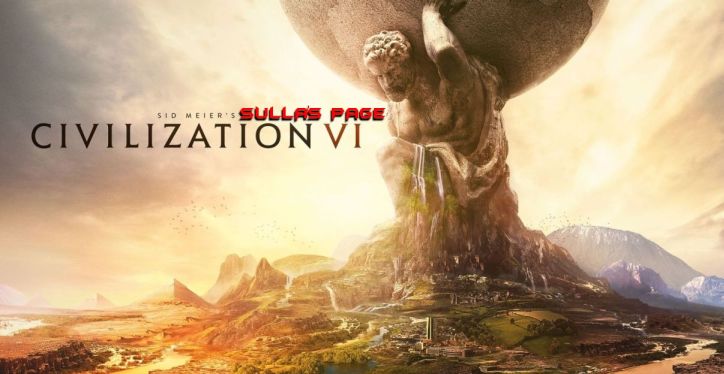

The last page of the report detailed the turns in which The Black Sword finished meeting his neighbors on the starting continent and constructed his initial districts. With an exceedingly early Ancestral Hall and absurdly strong Cree trade routes in play, TBS was in a position to develop his new cities and expand across the map faster than his rivals. With everyone having signed Delcarations of Friendship with one another to rule out direct conflict, it was the city states that began attracting the attention of the players. The city state benefits have been weakened significantly in the Civ6 expansions, requiring districts to have completed the tier 1 building (library, shrine, marketplace, etc.) to recieve the corresponding 3 envoy benefit and the tier 2 building (university, temple, bank, etc.) to receive the 6 envoy benefit. This makes it an even easier decision to capture the city states rather than patronizing them with envoys, and that was the goal on each player's minds during these turns.
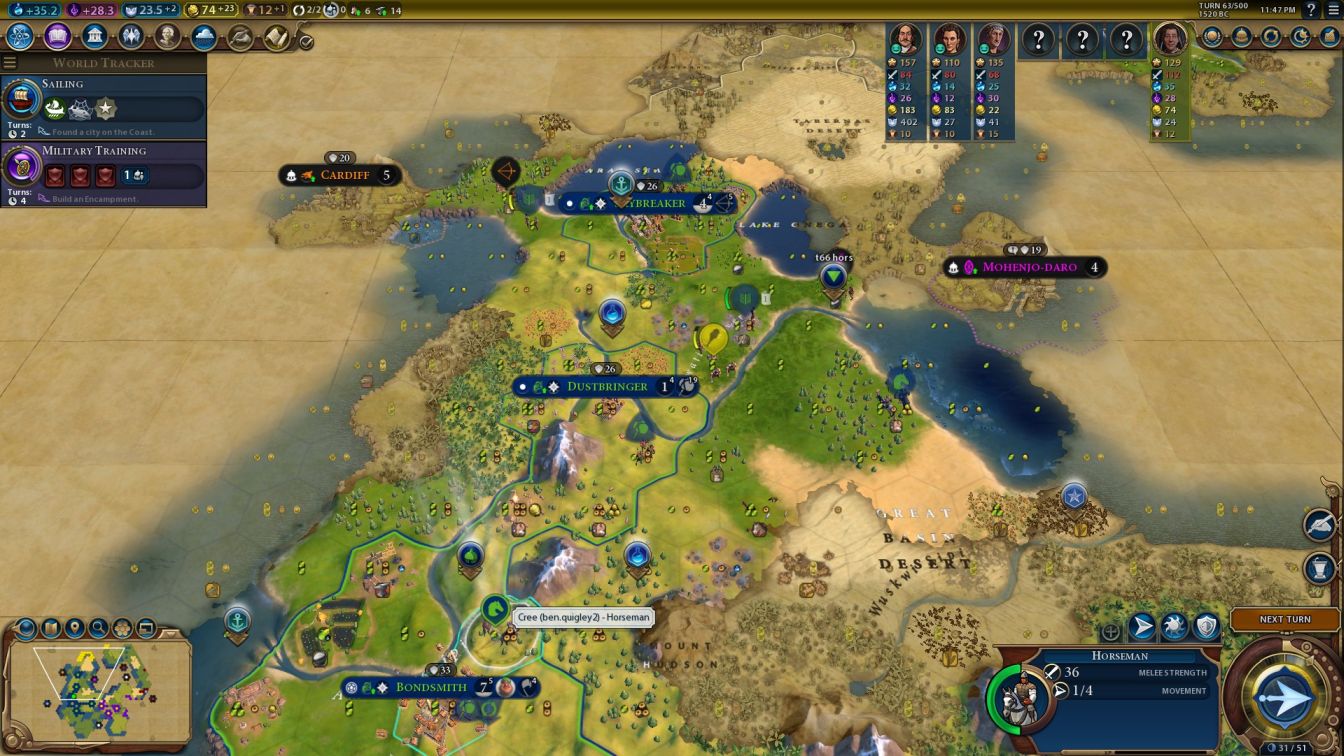
|
The Black Sword: |
This was another period of relatively sparse reporting from TBS with a gap of eight turns since the previous images of the homeland cities. In that relatively brief span of time, both Skybreaker and Lightweaver had grown from size 1 up to size 4 and were now significant contributors to the wider Cree empire. Bondsmith used the Colonization policy and the Ancestral Hall to knock out a fast settler with +100% production and used it for the Dustbringer spot pictured above. This was going to be an amazing city with enormous amounts of food, production, gold, and science. It wouldn't take long to get this spot going once it received another one of those ridiculous Cree trade routes. TBS had been limited to two trade routes up to this point in time (the free Cree trader and the one normal trader) but it wouldn't take much longer before he researched to Celestial Navigation tech and unlocked Harbor districts. There's a change in Gathering Storm to the Veterancy policy that grants +30% production to Harbor districts and their buildings as well as to the Encampment districts from the non-expansion game. This was another area where TBS was looking to make use of the unique Cree benefits by getting more total trade routes in play.
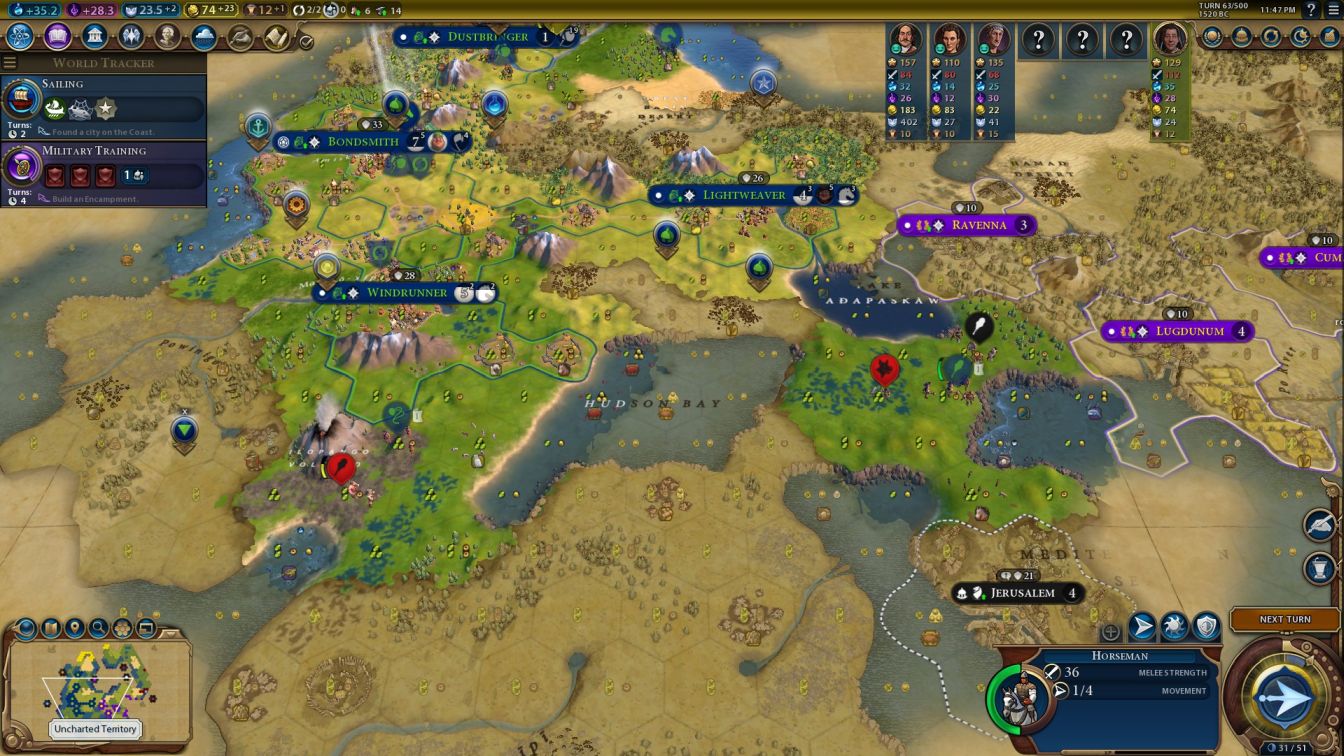
Meanwhile, the south was a bit more contested with Cornflakes settling a border city at Ravenna right where TBS had predicted it would be placed. There were still plenty of barbarians running around in the deep south and TBS was training some units both to keep them down and get a move on the nearby city states. Lightweaver was already able to produce horseman units in 4 turns while running the Maneuver policy for +50% production on mounted units. Pretty insane for a city that didn't exist ten turns earlier. TBS had also scored enough era points to unlock a Golden Age when the Classical era began on Turn 61 so let's take a look at the different options available there:

This picture was taken from TheArchduke's thread since TBS didn't post a screenshot when he started his own Golden Age. Era score is one of the featured added in the expansions, awarding different points for accomplishing various different feats. This could be anything from clearing a barbarian camp to discovering another civilization to building a district for the first time to becoming suzerain of a city state. There's a long list of different things that grant era score points and differing amounts of points are awarded for achieving different objectives. Scoring enough points in each era will grant a Dark Age, Normal Age, or Golden Age, each of which grant the possibility of enacting different dedications for the duration of that age. Dark Ages and Golden Ages are both very useful with only the Normal Ages being pretty bland.
Everyone seemed to have no trouble accumulating enough points for the initial Golden Age. All four of the Classical era Golden Age options are powerful and can open up different empire-wide strategies. TBS had nothing in his civ leading him towards a particular path and went with the default best option: Pen, Brush, and Voice. This dedication causes civics boosts to be worth 50% of the civic costs instead of 40% (just like in pre-expansion days) and can save the player quite a bit of culture if they're hitting most of the boosts the way that they should. The dedication also re-enacts the Meritocracy policy from pre-expansion Civ6 by adding 1 culture/turn to all completed districts. Since culture is harder to acquire than beakers and the benefits of the civics tree are somewhat front-loaded, the Pen, Brush, and Voice policy tends to be a stronger pick in generic situations as compared to Free Inquiry, which has a similar benefit with regards to science. The Classical era often arrives too early to get the full benefit of Free Inquiry from Commercial and Harbor districts but the two effects of Pen, Brush, and Voice are always useful.
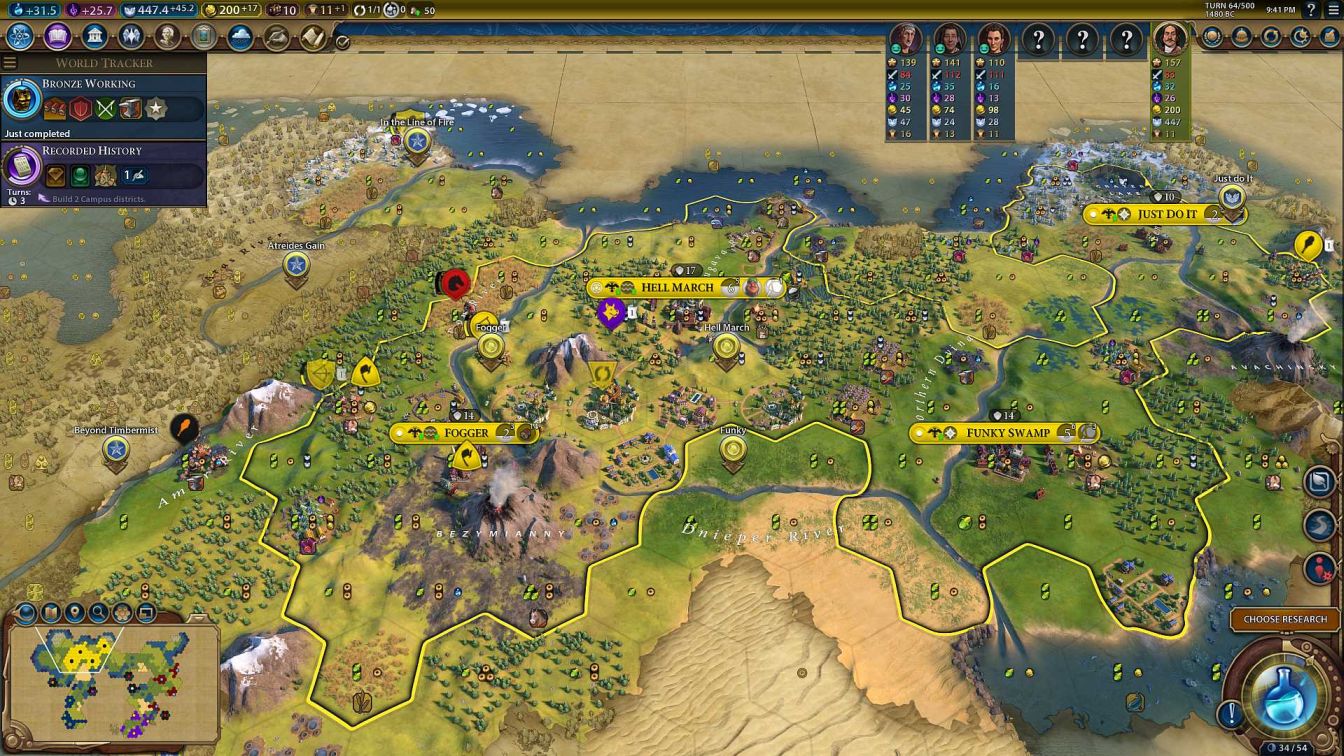
Some of the other players were emphasizing different strategies that led them towards other Golden Age dedications. TheArchduke's Russia was making use of the power of cheap Lavra districts to stack up a monstrous faith income, already reaching 45 faith/turn and climbing rapidly. TheArchduke had taken Earth Goddess for his pantheon and Choral Music for his religion's follower belief and this was granting him lots of culture from shrines and eventually temples. Monumentality was the perfect Golden Age dedication for this setup, granting +2 movement to all builders and effectively turning them into Indian Fast Workers from Civ4, along with allowing settlers/builders to be purchaseable with faith - and purchased at a 30% discount to boot! TheArchduke had saved up more than 600 faith prior to the Golden Age starting and was now burning through that stockpile to send a series of settlers out across the map. Backed by the power of religion, TheArchduke was keeping pace with the Cree science and culture output while still having the cossack unique unit lurking down the road for another power spike.
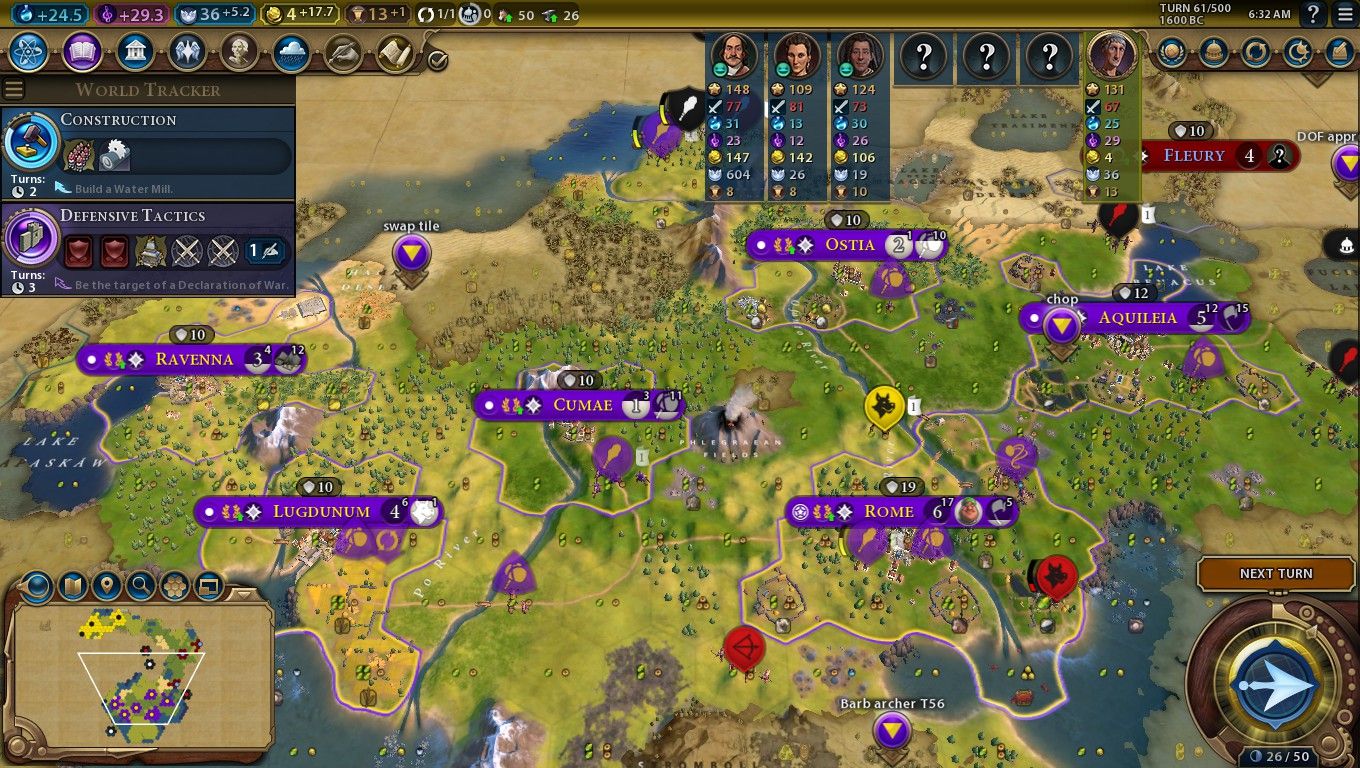
Meanwhile, Cornflakes was focusing on expanding as quickly as possible in the southeast. This was a natural strategy for Rome to follow given the civ's free monuments and road connections, and Cornflakes was indeed leading the pack in terms of number of cities founded. He was also working on the Pyramids and would complete the wonder a little bit later around Turn 70 for another nice boost. Cornflakes ended up picking Monumentality for his Golden Age dedication which was an odd choice given how little faith income he had. I think that this was taken mostly for the movement boost to workers and the opportunity to purchase them at a cheaper price. The problem for Cornflakes was a lack of completed districts to take advantage of Free Inquiry or Pen, Brush, and Voice. He was pushing expansion so hard that he was neglecting to build any districts, and that was a real problem as the game continued. If there's one district that's absolutely mandatory for Civ6 Multiplayer, it's the Campus district because there's no other consistent way to generate science. Cornflakes was trying to make due with beakers from population alone and that just wasn't sufficient as the game went on. His civ-wide science and culture numbers looked good at the moment but would increasingly stagnate as the turns rolled onwards.
And then there was Kaiser's Greece:

I had to use another one of TheArchduke's screenshots because Kaiser did not update his spoiler thread after the early turns of the game. It was becoming obvious to all of the players on the continent that Kaiser was significantly weaker than the other three empires. His overall development had stagnated and fallen behind due to a series of mistakes: building the second city much too far away from the capital, building a Holy Site district to compete for a religion despite the presence of Russia and Khmer in the game, emphasizing an early Magnus over an early Pingala for the governors, and so on. It's hard to say in too much detail what went wrong because Kaiser didn't update his spoiler thread but clearly things were souring over in Greece. Keep an eye on the leader comparisons at the top of the screen to get a sense for how Kaiser was falling behind, his science and culture and empire score noticeably lower than everyone else. TBS was greatly worried that Cornflakes or TheArchduke would tear through Kaiser and become an unstoppable runaway civ after incorporating all of the Greek lands.
Back in Cree territory, TBS was riding hard for the nearby city states with his horsemen:

|
The Black Sword: |
TheArchduke and Cornflakes were also posting in their spoiler threads about how they intended to attack and conquer the city states in their nearby vicinity. However, TBS simply beat them to the punch by having four horsemen out on the map at such an early date. He was simultaneously attacking Mohenjo-Daro in the north and Jerusalem in the south at the same time, something that the other players just didn't have the military resources on hand to accomplish. (TBS was double all of his neighbors in the military score rankings at this point in time thanks to those fast horseman units.) This was a case of stealing a march on the other players and taking strategic objectives faster than they could react; to the victors go the spoils.
TBS was also able to shift one of his trade routes over to Dustbringer and take advantage of the ludicrous yields resulting from sending it back to the capital: 7 food / 2 production / 4 gold per turn?! There's no way that was even remotely balanced! Dustbringer would therefore grow like a weed until it ran into the housing cap that limits city growth so badly in Civ6. Except that no, it wouldn't hit the housing cap, because the Cree have an answer for that too:
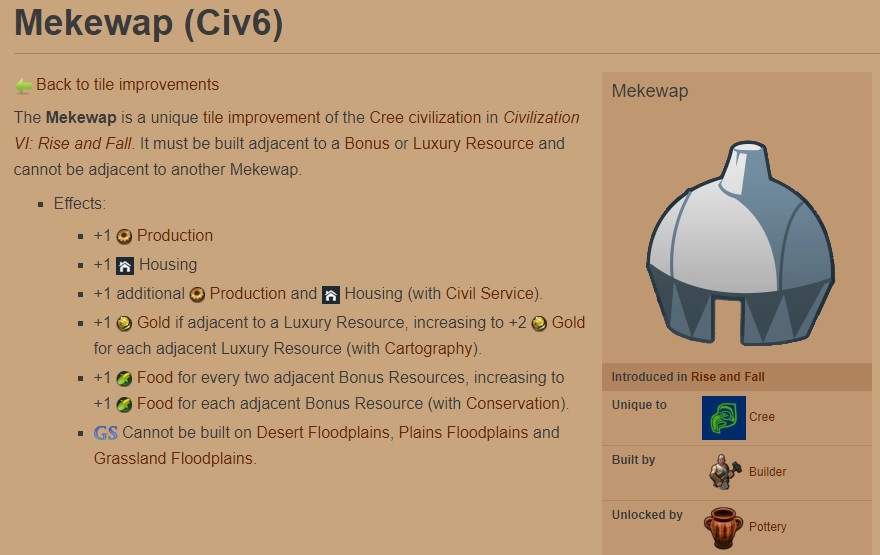
It was finally time to start making widespread use of the Cree unique tile improvement, the Mekewap. The mekewap produces a default +1 production and +1 housing, with those bonuses about to double for TBS to +2 production and +2 housing with the imminent arrival of Civil Service civic. Getting two points of housing for a single builder charge is an absurdly good rate of return; if a builder costs roughly 100 production and has 5 charges in the post-Feudalism era, then one charge used on a mekewap effectively grants 1 housing for 10 production. (Who needs Aqueduct or Neighborhood districts?) Note that the tile with the mekewap doesn't even have to be worked to gain the benefit of that extra housing which only makes the tile improvement that much better. Mekewaps also get additional food and gold if they happen to be placed next to multiple bonus and luxury resources, a feature that they definitely don't need to have. The one serious drawback to the mekewaps is the fact that they can only be placed next to bonus/luxury resources and can't be placed next to one another. That wasn't much of a restriction on this map though, which seemed to be stuffed full of resources everywhere.
So the Cree trade route bonus allowed TBS to grow any city at a fantastic rate, and the Cree mekewaps supplied housing (and more production!) at a ridiculously cheap cost. TBS was wisely taking advantage of both of these factors while also cranking out constant builders to keep all of his cities supplied with improved tiles as they grew upwards. Obviously the Cree unique bonuses were pretty silly in this game but it wasn't just the civ itself being strong here. More than any of the other players, TBS was focused on optimizing his cities and keeping them working the best tiles possible. I was advising TheArchduke as a dedicated lurker in this game and my biggest regret in retrospect was not using Monumentality for more builders. We could have pushed out more Russian builders to keep working improved tiles and TBS just did a better job in this regard.
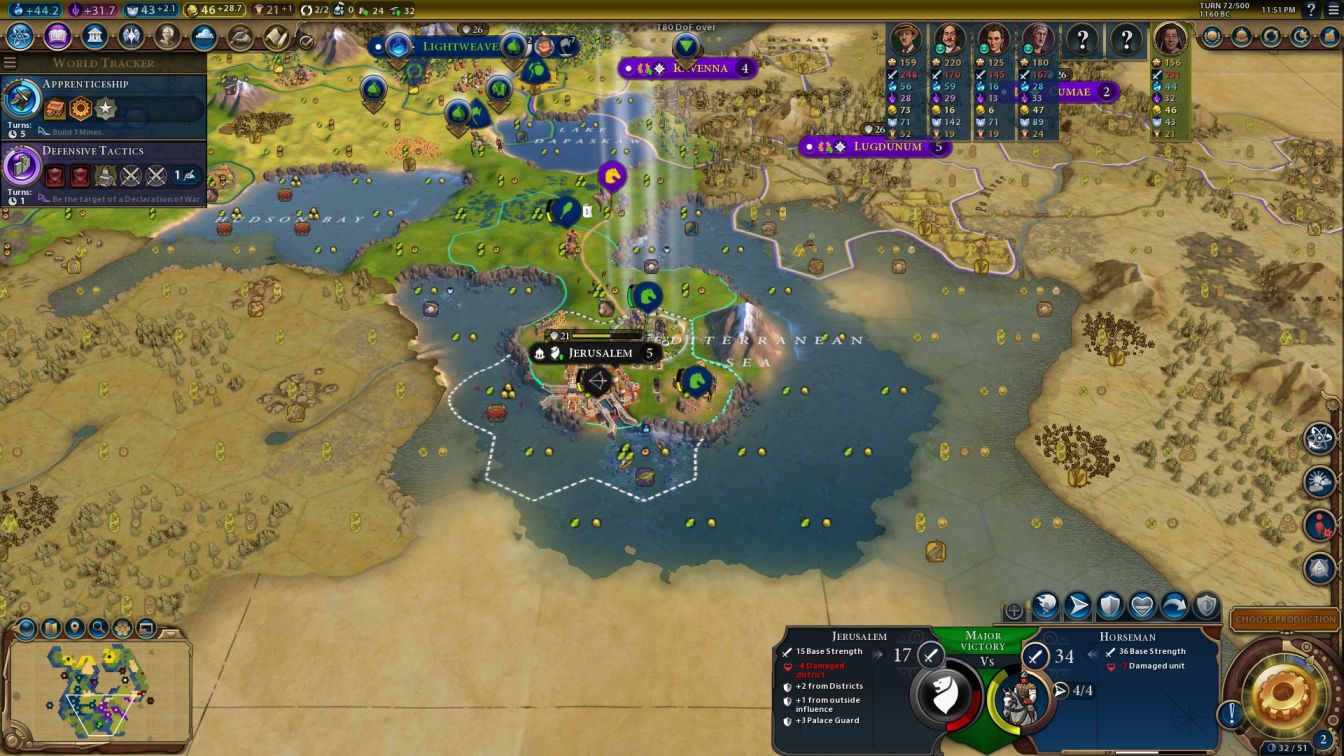
Mohenjo-Daro and Jerusalem both fell to Cree forces on Turn 72. This led to Cornflakes reflecting back on this development as a missed opportunity:
|
Cornflakes: |
With Mohenjo-Daro and Jerusalem in hand, TBS had swelled from five cities to seven cities in one stroke. Devouring these two locations allowed him to keep pace with Rome's mostly district-less expansion and Russia's Monumentality faith-purchased settlers. The next standoff was taking place outside the remaining city state of Cardiff where a narrow one-tile landbridge controlled access to the city:
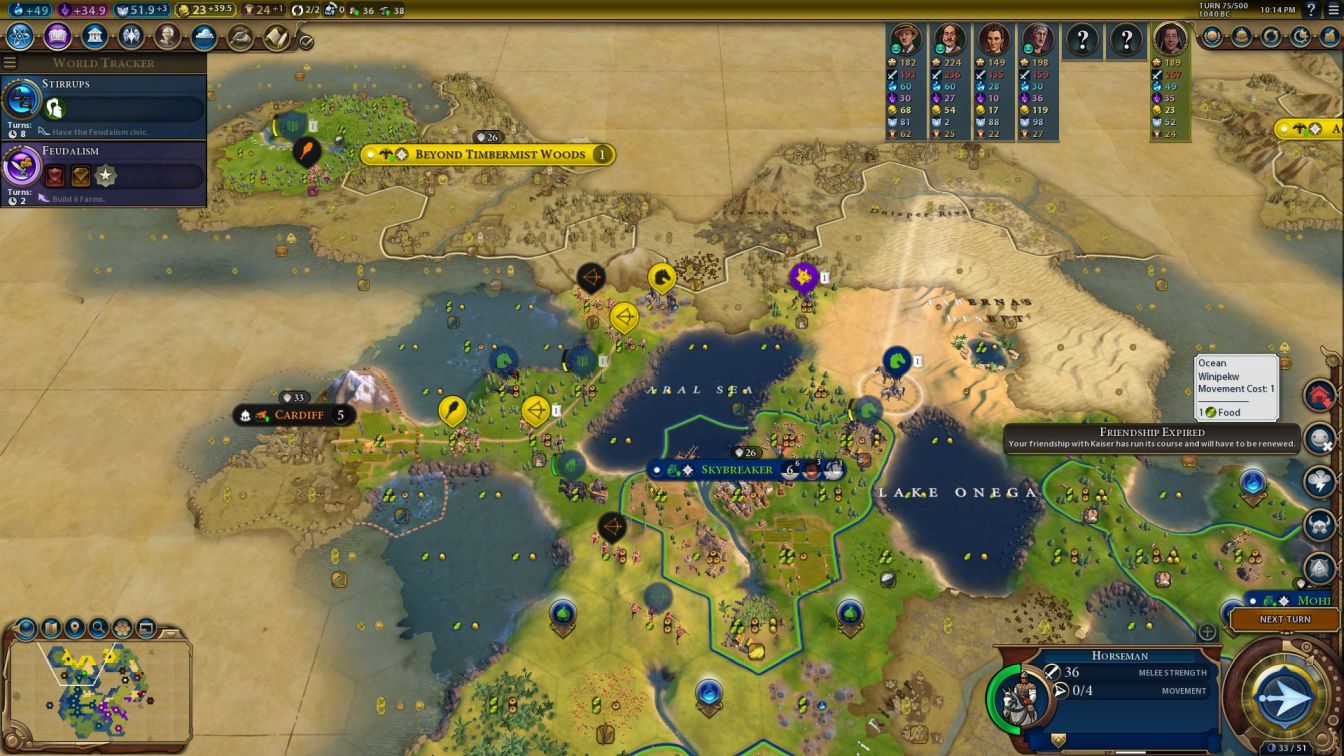
|
The Black Sword: |
The Cree and Russia were roughly comparable in total military strength and also in the number of units present in the theatre of conflict around Cardiff. TBS was hoping that he would be able to gain control of the seas to the west of the city state since he had finished a Harbor at his capital city and was in the process of training some quadrireme units. The whole situation was slightly farcical since neither side could declare war on the other by virtue of their shared Declaration of Friendship. In any case, TheArchduke deployed an unexpected tactic in the form of a settler ready to grab control of the area:
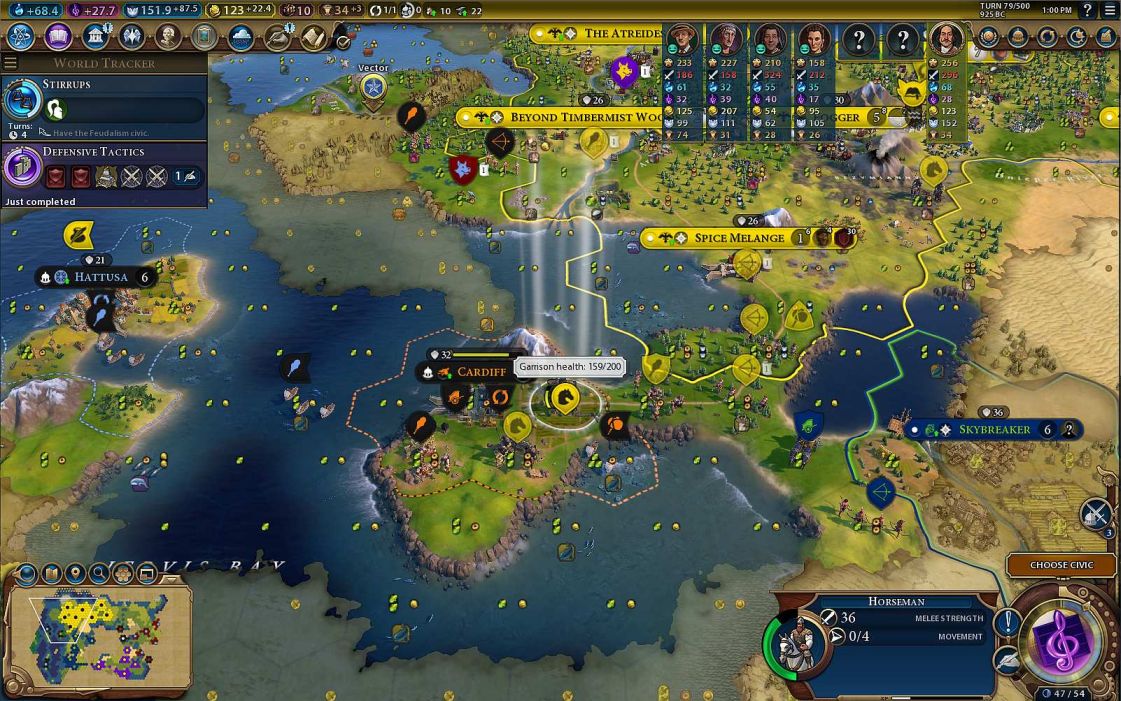
|
The Black Sword: |
But it turned out that this was one situation where TBS was wrong in this game, with TheArchduke moving too quickly against the city state. By the time that the Declaration of Friendship had run out between the Cree and Russia, Cardiff was already under TheArchduke's control:

The Russian capture of Cardiff served to maintain the balance of power in this part of the world instead of turning the Cree into an unstoppable juggernaut. If TBS had swept every city state within nearby reach, it would have been difficult to see any of the other players putting up much of a fight, especially at sea. Instead Russia largely kept pace for the moment, with TBS and TheArchduke starting to pull away from the rest of the pack. Both of them had double the science rate of Rome and Greece along with good prospects for future expansion. Contact was also popping up with the three civilizations on the other continent as the sea lanes opened up, and they would begin to factor into the strategic considerations moving forward as well. With the early game Declarations of Friendship about to run out, this game faced the prospect of serious confrontation between the major empires for the first time.



